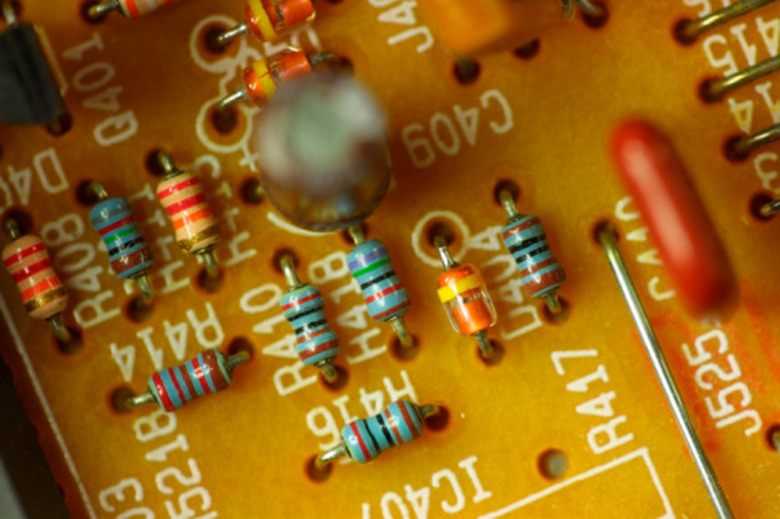Advantages & Disadvantages Of A Parallel Circuit
When connected in a series, components are arranged one after the other like train cars. The battery drives current through the series circuit, which is a closed loop, so the current must be the same through each resistor.
Think of the battery as a pumping station, current as water and the resistors as houses. This circuit is like a neighborhood where water is pumped through all the houses sequentially until finally returning to the pumping station. In this case, the same amount of water must flow through each house.
Ohm's law relates voltage, current and resistance and may be expressed as:
\(V=IR\)
Where:
V = Voltage across a resistor
I = Current through the resistor
R = Resistance
If current is the same through all the resistors in series, Ohm's law indicates the voltage across an individual component may vary, depending on its resistance.
What Is a Parallel Connection?
What Is a Parallel Connection?
In contrast, in a parallel circuit, resistors or devices are connected like the rungs of a ladder. A parallel circuit is like a neighborhood where each house is on its own branch of the water line and may draw a different amount of water without affecting the others.
Ohm's law, expressed to calculate current, is: I = V/R. When parallel resistors are connected to a voltage supply, each component has the same voltage across it but may draw differing current, again depending on the individual resistance.
Calculating Series and Parallel Equivalent Resistances
Calculating Series and Parallel Equivalent Resistances
A series collection of resistors R1, R2, R3, . . . is equivalent to a single resistor, Rs, equal to the sum of all the resistances:
\(R_s = R_1 + R_2 + R_3 + . . .\)
As a result, inserting a resistor into a series circuit always increases the equivalent resistance.
Resistors R1, R2, R3, . . . in parallel also act as a single resistor, but the calculation of equivalent resistance Rp is more complicated, given by:
\(\frac{1}{R_s}=\frac{1}{R_1}+\frac{1}{R_2}+\frac{1}{R_3}+...\)
Adding a resistor in parallel to a circuit always decreases the equivalent resistance. This relationship has interesting implications in determining the disadvantages or advantages of a parallel circuit.
Advantages of a Parallel Connection
Advantages of a Parallel Connection
The disadvantages or advantages of a parallel combination of elements depends on the situation. Houses, for example, are wired so electrical devices may be used in parallel. When a refrigerator is plugged into a kitchen outlet, it consumes electricity without affecting voltage or current in the rest of the home – and therefore does not affect the operation of any other appliance. This is one of the advantages of a parallel connection.
The bulbs on a string of modern Christmas lights are also connected in parallel. If one bulb burns out, it becomes an open circuit that doesn't affect the other bulbs. The rest of the string remains illuminated. Because the single dark bulb is immediately obvious, it can be easily found and replaced – again an advantage of a parallel circuit.
Old-style Christmas lights were connected in series, and a burnt-out bulb stopped current through the entire string, shutting off all the lights. Imagine how hard it would be to find the one bad bulb!
The disadvantage of a parallel connection becomes apparent with a short circuit, such as when someone jams a wire between the two contacts of an electrical outlet. A short circuit has very low resistance, which in turn causes current in the circuit to increase tremendously, and bang! Sparks fly and the wiring heats, possibly causing a fire.
Fortunately, the fuse blows and becomes an open circuit. Because it is in series with the wiring, the fuse does its job and stops the current flow before anything can be damaged.
Cite This Article
MLA
Lee, H.L.M.. "Advantages & Disadvantages Of A Parallel Circuit" sciencing.com, https://www.sciencing.com/advantages-disadvantages-parallel-circuit-8547192/. 22 December 2020.
APA
Lee, H.L.M.. (2020, December 22). Advantages & Disadvantages Of A Parallel Circuit. sciencing.com. Retrieved from https://www.sciencing.com/advantages-disadvantages-parallel-circuit-8547192/
Chicago
Lee, H.L.M.. Advantages & Disadvantages Of A Parallel Circuit last modified March 24, 2022. https://www.sciencing.com/advantages-disadvantages-parallel-circuit-8547192/
